Day Nine and Wadi Sura
We woke early and packed the camp. We are getting better at this. I was cold and had not slept well - so was quite content to hear that we had a day with a lot of driving.
I have been enchanted with my traveling companions. Marita and Jean-Daniel are a delight and talk about as much as I would want, but not all the time. Both have excellent and fluent English - and their French, which they use when together is so clear that I follow it easily if I bother to concentrate. We have discussed everything - both are thinkers and sharply intelligent and humorous. They even forgive my occasional Aussie crudeness when comments just slip out.
We had come to this side of Gilf Kebir so fast yesterday - approaching from the desert and running up the edge so I really did not have time to take it in. Leaving today we are hugging close to the high escarpments and can see the amazing stacked sandstone formations.
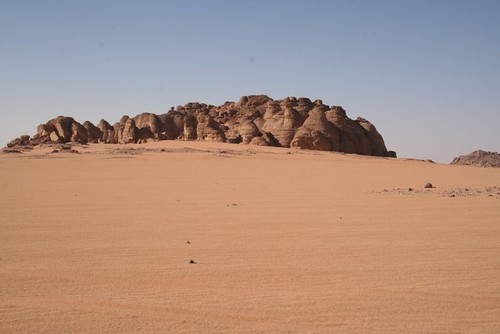
Occasionally I took a shot straight through the windscreen from the backseat. I like the juxtaposition of Hani's strong hands, the rear view mirror, and the view in front. The small dot low in the middle is the lead car.
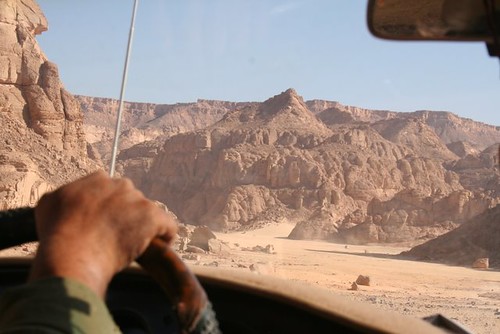
We pulled in to see the Swimmers' Cave. This was featured in the movie The English Patient - and I loved the movie. I had always been enchanted by that cave - the deep slit that the shepherd edged into, down and around tight bends, with his flaming torch lighting stunning paintings on the walls. I thought the swimming figures beautiful and it was such an odd combination, swimmers in the middle of the desert. It implied a long time passing from then till now, and since 'now' cannot be shifted 'then' must be a very long time ago - a time when the climate was completely different, not just wet enough to sustain people but wet enough to swim.
I had been warned. Heide had mentioned that it was a shame that people had damaged it, wetting the images - which might not have seen water for centuries - for better photos. Darkening seemed to imply that some had used oil. Apparently some images were actually missing.
The cave was the greatest disappointment of the trip. For a start, the film lied. It was a shallow, low, shelter - curved and only slightly overhung like the other caves we have seen. There were no deep slits to climb through, no suggestion of darkness that might need a torch. I almost did not believe they had the right place. The paintings copied from these walls that now decorate the stunning foyer in the International Hot Springs Hotel in Bahariya are a great advance on anything left here - and in a way will remain the memorial for the Cave of the Swimmers.
Worse - there is hardly anything left. The way the rock has formed left it cracked and flaky - though hard enough to last for centuries - as long as no-one tries to lever pieces off with tyre irons. It looks as if that has happened here again and again. It was devastating to see it and I wanted to avert my eyes and cry. There are great light scars in the wall of the rock, and shattered edges of figures swimming now into nowhere.
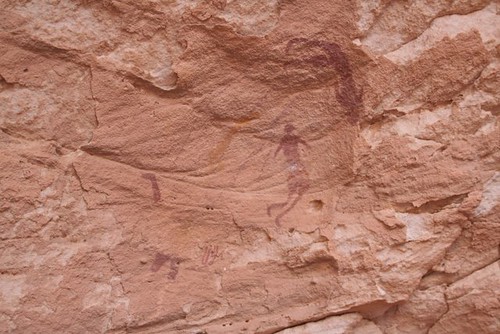
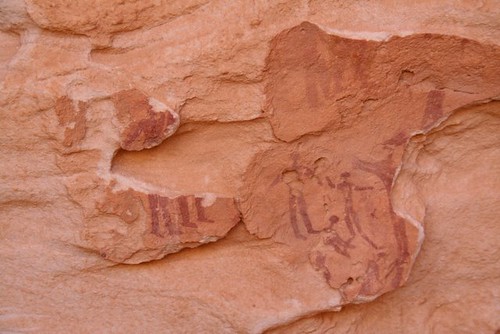
And a view of the cave.
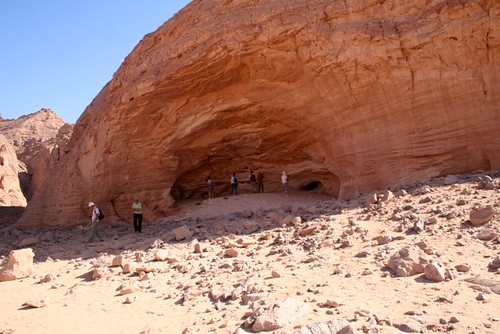
I have no idea what might be done to protect other caves from similar damage. While tourism to these areas is difficult, it is also sought after by those who want to join an increasing movement to go to places others have not been. Tourism does marvelous things to increase awareness of what is of value on this earth of ours, but it also allows people to access things that are so precious and fragile. Our guides were wonderful. Mahmoud spoke with passion about guides 'from Cairo' who turn a blind eye to damage done - but he sees the existence of things like the caves which are the treasures of Gilf Kebir as essential to his continuing tours. The flower stones of the White Desert are disappearing (and I have some in a bowl in my lounge room, and each time I go back now I take a handful home). The silica glass which was formed over a huge area of Egyptian Desert in one extraordinary meteor strike, which shattered into shards which were worn silken and pitted by wind and sand, to glow like greenish and golden translucent jewels on the sands of the Great Sand Sea - most has been collected by tourists. I saw whole big monuments built in this natural glass in Tripoli, the capital city of Libya.
I am now so afraid for places like the fairly recently found Fugini Cave - so stunning and haunting and beautiful. Special places in isolated areas afford unusual opportunities for plunder as there is unlikely to be an interruption. I would hate to see tourism banned as I found my whole trip so magical and it would be churlish to assume that all other tourists are worse than I am.
We left the cave, all a bit quiet and distressed.
Next stop was a camp used by the British - called the British Camp - funny about that! We had hooked out towards the desert (and Libya) again and the stacks of sandstone looked designed to be pigeon houses, pitted and worn and sculptured.
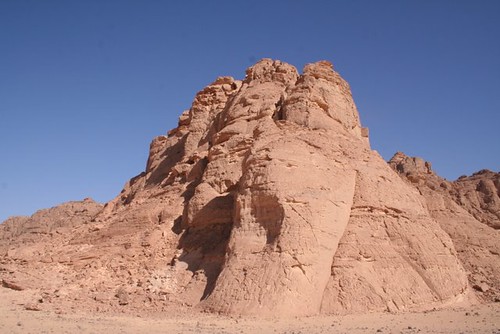
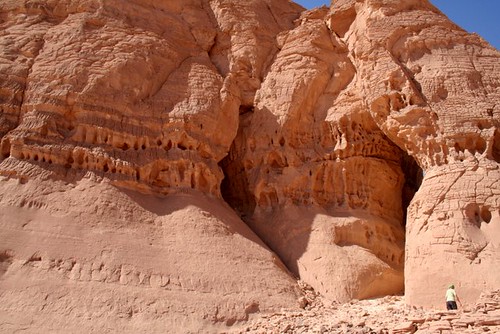
The sky was deep ultramarine, and the sun was impossible to avoid with shadows sitting like tight puddles under the rocks. Stones in this area are like jewels - not silica glass, but softly translucent, white like thinned milk, cool apricot and cream colours, all etched by sand and wind so that if you lift them from the firmed-down gravel which embeds them they spread wider and rougher below the ground level, and are smooth and polished above. You hold them in you hand like eggs, and the polished side lets you look into the stones, the dull side below stops you seeing your own palm straight through them.
We did not stay long - all of us needed toilet stops and we had bolted for varying degrees of cover. There was one track through the rocks and it is surprisingly hard to get away from twelve people all demanding a space of their own while pretending to search for pretty pebbles.
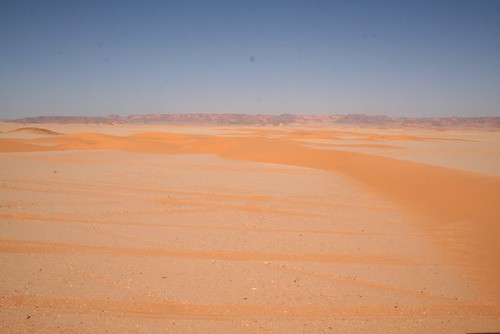
Now we swung south again. We ran parallel and fast through red sand with the Gilf in the distance. Further away the sand is firmer and less likely to trap Alberto's car. Fingers of the soft stuff work like speed humps and are surprisingly hard to see in mid-day sun with no shadows.
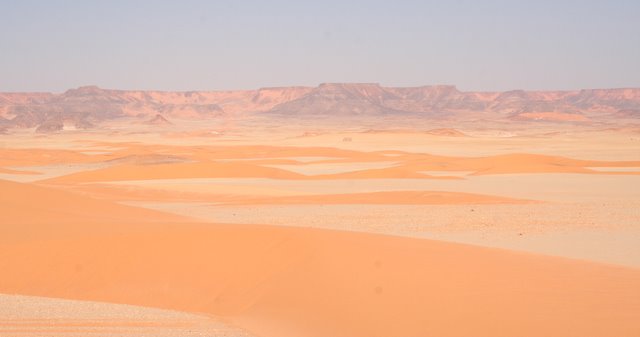
It is amazingly beautiful.
Now the real fun starts. We were to cross the Gilf at the Aqaba Pass and this meant we had to climb to the top of the Gilf. I had asked rather tentatively about this. I was told it used to be very difficult but now the sand had filled the rocky places it was not so bad, but very soft.
We went up, and up, and up, sand dune after sand dune. I lost count of how often we had to run back - not me actually if I am honest - but the other drivers and Mohamed the Captain - to dig out Alberto from soft sand. Going up with only two wheel drive was so difficult - lose speed even a little - and it was very steep and inevitable - and the back wheels simply drove the front wheels into the sand, then dug themselves in.
I wish I had photos but it was impossible to hold on and use an SLR from the back seat with images that were even half way reasonable.
At the top the world flattened out. The plateau was rimmed with black ridges and high black peaks, but the sand between shifted and drifted in the keening wind that swept across it and swung at the cars, snatching especially at the higher and heavily laden kitchen car. It felt uneasily as if we were driving on a treadmill that just moved under the wheels so we went nowhere, and the scenery hardly changed.
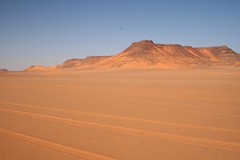

Up one side, and down the other.
We dropped only one more dune.
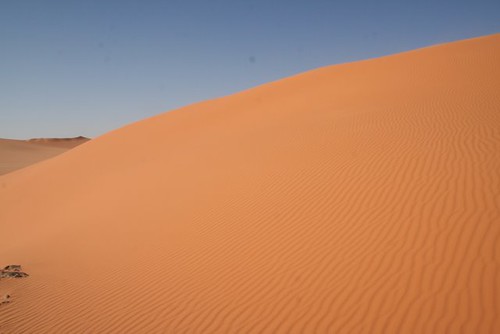
We threaded our way down through the sand, and came to a high ridge with a long sand slope below and wave after wave the Great Sand Sea stretched out pale red and gold before us.
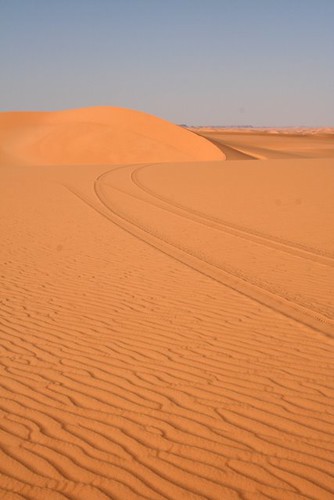
We swung around to face one of the most amazing views I will ever see. Without a wide angle lens I can give you only one direction, but it wrapped almost around us. The sand glowed golden as the sun when down, and ridges dropped and seemed to change shape as shadows shifted and sharpened - from the softest wash of grey-lilac to mauve to red-violet and finally deep grapey purples. The light cooled on the sand as the heat sank from the air and the cold slammed down on us.

I did not put up a tent. I was so enthralled by the colours that I refused to take my eyes off the sand dunes, even when my friend Mohamed, and then Mahmoud, came up to tentatively offer to help.
I put my tent straight on the sand, to sleep near the men around the campfire. I had mentioned that I had my Ipod and could put on some music to play through the car speakers if people wanted. I had hardly used it. I had brought it as an isolating device if there should be people who want ed to talk all the time - but the whole group has been delightful and talking has been a pleasure. Even more, the places have demanded silence to fall between the gaps left by voices, so the stillness can feed in and around us and the silence is so total that it almost leaves you straining to hear anything at all. Heide had asked about Abba, and I assured her that I had an eclectic collection which did indeed include Abba.
We ate, then I put on music. I had decided that Abba did not entirely suit the place, and instead chose the sound track of 1492, The Conquest of Paradise by Vangelis. It is currently almost my favourite piece of music. The choral voices - only men, floated out across the sand and the whole group fell into unusual silence until the whole CD was over. "That," said Jean-Daniel. "was absolutely beautiful - what was it."
Then we put on Abba and some danced. It was a lovely night, cold and icy but so utterly still and beautiful. The moon was out over the sand and you could almost read by it, even though it was not the full moon we had had earlier in the trip.
The men cosseted me. I know they had been so concerned about the coughing. Now Mohamed, the driver of the kitchen car set up my bed. I had dropped the mattress and rolled out my sleeping bag and the tiny feather cushion filler I was using as a pillow. Mohammed lifted the pillow, folded a camel blanket to a thick ridge and put it underneath - which both extended the length of the mattress and lifted my head higher. Another camel blanket was carefully folded around the whole bed. I drifted straight off to sleep with not one cough. As I sank into that warm and comfortable state that knows you are awake but could not be bothered moving I felt Mohamed beside me stand and move around the circle to check all of us. One after another he adjusted our blankets, Mahmoud's had shifted sideways, and he tucked it in. The captain's had slid back and he pulled it up over his shoulder. I was aware of gentle hands adjusting the heavy rug around my shoulders and weighting the sides with sand so it could not move. Nor could I, but then I didn't really want to.
I slept like a log and did not use a tent again.
I have been enchanted with my traveling companions. Marita and Jean-Daniel are a delight and talk about as much as I would want, but not all the time. Both have excellent and fluent English - and their French, which they use when together is so clear that I follow it easily if I bother to concentrate. We have discussed everything - both are thinkers and sharply intelligent and humorous. They even forgive my occasional Aussie crudeness when comments just slip out.
We had come to this side of Gilf Kebir so fast yesterday - approaching from the desert and running up the edge so I really did not have time to take it in. Leaving today we are hugging close to the high escarpments and can see the amazing stacked sandstone formations.

Occasionally I took a shot straight through the windscreen from the backseat. I like the juxtaposition of Hani's strong hands, the rear view mirror, and the view in front. The small dot low in the middle is the lead car.

We pulled in to see the Swimmers' Cave. This was featured in the movie The English Patient - and I loved the movie. I had always been enchanted by that cave - the deep slit that the shepherd edged into, down and around tight bends, with his flaming torch lighting stunning paintings on the walls. I thought the swimming figures beautiful and it was such an odd combination, swimmers in the middle of the desert. It implied a long time passing from then till now, and since 'now' cannot be shifted 'then' must be a very long time ago - a time when the climate was completely different, not just wet enough to sustain people but wet enough to swim.
I had been warned. Heide had mentioned that it was a shame that people had damaged it, wetting the images - which might not have seen water for centuries - for better photos. Darkening seemed to imply that some had used oil. Apparently some images were actually missing.
The cave was the greatest disappointment of the trip. For a start, the film lied. It was a shallow, low, shelter - curved and only slightly overhung like the other caves we have seen. There were no deep slits to climb through, no suggestion of darkness that might need a torch. I almost did not believe they had the right place. The paintings copied from these walls that now decorate the stunning foyer in the International Hot Springs Hotel in Bahariya are a great advance on anything left here - and in a way will remain the memorial for the Cave of the Swimmers.
Worse - there is hardly anything left. The way the rock has formed left it cracked and flaky - though hard enough to last for centuries - as long as no-one tries to lever pieces off with tyre irons. It looks as if that has happened here again and again. It was devastating to see it and I wanted to avert my eyes and cry. There are great light scars in the wall of the rock, and shattered edges of figures swimming now into nowhere.


And a view of the cave.

I have no idea what might be done to protect other caves from similar damage. While tourism to these areas is difficult, it is also sought after by those who want to join an increasing movement to go to places others have not been. Tourism does marvelous things to increase awareness of what is of value on this earth of ours, but it also allows people to access things that are so precious and fragile. Our guides were wonderful. Mahmoud spoke with passion about guides 'from Cairo' who turn a blind eye to damage done - but he sees the existence of things like the caves which are the treasures of Gilf Kebir as essential to his continuing tours. The flower stones of the White Desert are disappearing (and I have some in a bowl in my lounge room, and each time I go back now I take a handful home). The silica glass which was formed over a huge area of Egyptian Desert in one extraordinary meteor strike, which shattered into shards which were worn silken and pitted by wind and sand, to glow like greenish and golden translucent jewels on the sands of the Great Sand Sea - most has been collected by tourists. I saw whole big monuments built in this natural glass in Tripoli, the capital city of Libya.
I am now so afraid for places like the fairly recently found Fugini Cave - so stunning and haunting and beautiful. Special places in isolated areas afford unusual opportunities for plunder as there is unlikely to be an interruption. I would hate to see tourism banned as I found my whole trip so magical and it would be churlish to assume that all other tourists are worse than I am.
We left the cave, all a bit quiet and distressed.
Next stop was a camp used by the British - called the British Camp - funny about that! We had hooked out towards the desert (and Libya) again and the stacks of sandstone looked designed to be pigeon houses, pitted and worn and sculptured.


The sky was deep ultramarine, and the sun was impossible to avoid with shadows sitting like tight puddles under the rocks. Stones in this area are like jewels - not silica glass, but softly translucent, white like thinned milk, cool apricot and cream colours, all etched by sand and wind so that if you lift them from the firmed-down gravel which embeds them they spread wider and rougher below the ground level, and are smooth and polished above. You hold them in you hand like eggs, and the polished side lets you look into the stones, the dull side below stops you seeing your own palm straight through them.
We did not stay long - all of us needed toilet stops and we had bolted for varying degrees of cover. There was one track through the rocks and it is surprisingly hard to get away from twelve people all demanding a space of their own while pretending to search for pretty pebbles.

Now we swung south again. We ran parallel and fast through red sand with the Gilf in the distance. Further away the sand is firmer and less likely to trap Alberto's car. Fingers of the soft stuff work like speed humps and are surprisingly hard to see in mid-day sun with no shadows.

It is amazingly beautiful.
Now the real fun starts. We were to cross the Gilf at the Aqaba Pass and this meant we had to climb to the top of the Gilf. I had asked rather tentatively about this. I was told it used to be very difficult but now the sand had filled the rocky places it was not so bad, but very soft.
We went up, and up, and up, sand dune after sand dune. I lost count of how often we had to run back - not me actually if I am honest - but the other drivers and Mohamed the Captain - to dig out Alberto from soft sand. Going up with only two wheel drive was so difficult - lose speed even a little - and it was very steep and inevitable - and the back wheels simply drove the front wheels into the sand, then dug themselves in.
I wish I had photos but it was impossible to hold on and use an SLR from the back seat with images that were even half way reasonable.
At the top the world flattened out. The plateau was rimmed with black ridges and high black peaks, but the sand between shifted and drifted in the keening wind that swept across it and swung at the cars, snatching especially at the higher and heavily laden kitchen car. It felt uneasily as if we were driving on a treadmill that just moved under the wheels so we went nowhere, and the scenery hardly changed.


Up one side, and down the other.
We dropped only one more dune.

We threaded our way down through the sand, and came to a high ridge with a long sand slope below and wave after wave the Great Sand Sea stretched out pale red and gold before us.

We swung around to face one of the most amazing views I will ever see. Without a wide angle lens I can give you only one direction, but it wrapped almost around us. The sand glowed golden as the sun when down, and ridges dropped and seemed to change shape as shadows shifted and sharpened - from the softest wash of grey-lilac to mauve to red-violet and finally deep grapey purples. The light cooled on the sand as the heat sank from the air and the cold slammed down on us.

I did not put up a tent. I was so enthralled by the colours that I refused to take my eyes off the sand dunes, even when my friend Mohamed, and then Mahmoud, came up to tentatively offer to help.
I put my tent straight on the sand, to sleep near the men around the campfire. I had mentioned that I had my Ipod and could put on some music to play through the car speakers if people wanted. I had hardly used it. I had brought it as an isolating device if there should be people who want ed to talk all the time - but the whole group has been delightful and talking has been a pleasure. Even more, the places have demanded silence to fall between the gaps left by voices, so the stillness can feed in and around us and the silence is so total that it almost leaves you straining to hear anything at all. Heide had asked about Abba, and I assured her that I had an eclectic collection which did indeed include Abba.
We ate, then I put on music. I had decided that Abba did not entirely suit the place, and instead chose the sound track of 1492, The Conquest of Paradise by Vangelis. It is currently almost my favourite piece of music. The choral voices - only men, floated out across the sand and the whole group fell into unusual silence until the whole CD was over. "That," said Jean-Daniel. "was absolutely beautiful - what was it."
Then we put on Abba and some danced. It was a lovely night, cold and icy but so utterly still and beautiful. The moon was out over the sand and you could almost read by it, even though it was not the full moon we had had earlier in the trip.
The men cosseted me. I know they had been so concerned about the coughing. Now Mohamed, the driver of the kitchen car set up my bed. I had dropped the mattress and rolled out my sleeping bag and the tiny feather cushion filler I was using as a pillow. Mohammed lifted the pillow, folded a camel blanket to a thick ridge and put it underneath - which both extended the length of the mattress and lifted my head higher. Another camel blanket was carefully folded around the whole bed. I drifted straight off to sleep with not one cough. As I sank into that warm and comfortable state that knows you are awake but could not be bothered moving I felt Mohamed beside me stand and move around the circle to check all of us. One after another he adjusted our blankets, Mahmoud's had shifted sideways, and he tucked it in. The captain's had slid back and he pulled it up over his shoulder. I was aware of gentle hands adjusting the heavy rug around my shoulders and weighting the sides with sand so it could not move. Nor could I, but then I didn't really want to.
I slept like a log and did not use a tent again.


6 Comments:
How fabulous, I love the little tale at the end. And how dire the desecration.
I have wonderful black and white videos (was old film) of my aunt going round Egypt in the 1930's. No one shall ever see it so empty again. And I suspect no one shall be able to repeat your trip.
Hi Jenny,
I found your blog while searching for someone reporting from Egypt. Have been reading through a lot of your entries and loved it. "The English Patient" is also one of my all-time favourites, and I can so relate to your magical trip.
One thing I've been meaning to comment on for some time already is that as far as I know the movie was filmed in Tunisia - perhaps that explains a few more location discrepancies.
Looking forward to your next posts,
Greetings from Singapore -
Christine
Those dunes are amazing! Thanks so much for posting these photos, for those of us that can't make it over there (yet).
It's breathtakingly beautiful, Jenny. Thank you.
Jenny... I know I've said this before, but I do hope that some day, maybe when you're back in Australia, that you will publish all these posts and photos in a book ... and I would very much like to sign myself up right now to be among the first to buy an autographed copy! I don't care what the book costs, or what postage is from wherever you happen to be to me here in Maine, but it shall be worth it!
Yes, make the art and share it, but please please DO share the words in a form that we can touch.... the screen is so fleeting but a page, a bound book with heavy paper and your incredible photography, and maybe the quilts that eventually come out of this sojourn......
I shall wait, patiently because I don't have much of a choice, but I shall be waiting {ggg}
Cheers, Sarah
I have just discovered your blog and there is so much I would love to comment about but won't because it could take a long long time. I loved seeing and reading about the Swimmers Cave, having seen The English Patient several times.
Post a Comment
<< Home